p.61
p.67
p.75
p.83
p.93
p.99
p.105
p.111
p.119
Effect of Cross-Section Stiffness on Strength of Rectangular Steel
Abstract:
Concrete-filled steel tubes (CFSTs) have better application in the application of beams and columns. This application form has obvious advantages, mainly because they are not restricted by the forming process, and the filled concrete does not need long-term maintenance. However, the design and analysis of steel-concrete beam-columns is a complex task involving many factors. In the design of CFSTs, it is essential to understand the influence of these factors on the behavior of steel-concrete members. In particular, the cross-sectional shape of the member has a significant impact on its bearing capacity, stiffness, and buckling behavior. However, there is relatively little research on the influence of member slenderness on the strength of CFSTs. Therefore, this study conducted an in-depth analysis of the stability of the member, and explored in detail the influence of the member slenderness ratio on the section properties and the overall bending strength of the beam. This study provides a basis for the application of CFSTs in beam-column design and analysis. In the bending strength analysis, the member slenderness ratio has an important influence. Smaller slenderness ratios have better strength performance, but the attenuation is also relatively significant. The larger the slenderness ratio, the slower and more stable the strength change becomes. In terms of section properties, when the slender section is reached, the influence of effective section reduction will be greater, and the strength reduction may exceed the engineering allowable error range. Therefore, special attention should be paid when using slender sections.
Info:
Periodical:
Pages:
93-98
Citation:
Online since:
August 2024
Authors:
Price:
Сopyright:
© 2024 Trans Tech Publications Ltd. All Rights Reserved
Share:
Citation:



